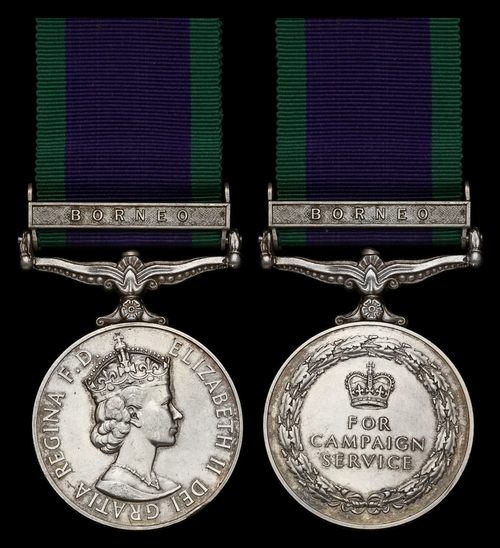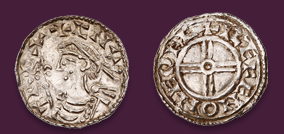
Auction: 25002 - Orders, Decorations and Medals
Lot: 27
The General Service Medal awarded to Corporal G. R. Chidgey, Special Air Service, who saw active service in Oman, Yemen and Borneo
General Service 1962-2007, 1 clasp, Borneo (19109029 Cpl. G. R. Chidgey. SAS.), good very fine
G. R. Chidgey - or Taff to his friends and comrades - hailed from Wales and enlisted circa 1947, given his service number. He is noted as serving in the Special Air Service in the context of the Oman campaign in 1958. In the book Geordie SAS Fighting Hero by Geordie Doran and Mike Morgan, a 'Taff Chidgey' is mentioned in the context of Oman 1958, serving in 16 Troop, 22 SAS and again in Yemen in 1963. There he operated alongside Doran and Jimmy Catterall (A Squadron), under the command of Johnny Cooper, Chidgey is noted as being a trained medic. Furthermore in One of the Originals Johnny Cooper refers to a Corporal "Chigley" (sic) who served as a medical orderly in B Squadron during the Yemen operation. Chidgey died in early 2003 and an editorial noting of his death appeared in the Mars & Minerva journal of December 2003 (Vol. 10, No.6).
'Britain's Secret SAS - Led Mission to Yemen (1963-1964)
In the early 1960s, a shadow war unfolded in the rugged highlands of Yemen concealed from the public eye and officially denied by the British Government. This covert campaign involved a number of Special Air Service veterans, including the renowned Johnny Cooper of 22 SAS and David Stirling, the regiment's founder, both with extensive Second World War exploits behind them. The operation represented Britain's secretive response to expanding Egyptian influence in the Arabian Peninsula.
Strategic Background
In 1962, Yemen's monarch, Imam al-Badr, was overthrown in a coup supported by Egypt's President Gamal Abdel Nasser. The new republican regime received substantial military backing from Egypt, which deployed tens of thousands of troops into the region. Concerned by this development and its implications for British interests in neighbouring Aden and the wider Gulf region, Britain sought to counter this influence through clandestine means. By April 1963, key figures from the Foreign Office, MI6, and the Ministry of Defence including MI6 Chief Dick White, Colonel Jim Johnson, Lieutenant Colonel John Woodhouse of 22 SAS and David Stirling convened in London. With open British military involvement deemed politically untenable, they authorised a covert mission to supply and advise the royalist Yemeni tribes. This would be carried out by ex-SAS personnel operating unofficially on the ground.
The Covert Campaign
The operation began with the secret transport of 50,000 rifles and millions of rounds of ammunition. These were flown from RAF bases in Wiltshire to Jordan, and then smuggled into Yemen. By late 1963, SAS veterans were on the ground, organising tribal resistance, conducting reconnaissance, and launching sabotage operations within republican-held areas. Among the key operatives were Johnny Cooper and Corporal "Taff" Chidgey. Cooper was of course a decorated SAS 'original' and wartime driver to David Stirling, who led the initial efforts. He trained tribal fighters, identified air-drop zones, and liaised with both Saudi and British intelligence channels. Though Stirling did not operate on the ground, he played a vital role behind the scenes drawing on his connections within the British establishment to mobilise manpower and resources.
Operations and Combat Engagements
A number of missions were executed during the Yemen campaign, including Operation Eggshell, Stirrup, Bangle, and Rancour. These focused on disrupting enemy supply lines, laying mines along infiltration routes, ambushing Egyptian military convoys, and training tribal forces in guerrilla tactics. One of the most significant successes occurred in early 1964, when a Cooper-led team including "Taff" Chidgey ambushed an Egyptian military column, resulting in approximately 85 enemy casualties. This marked a major tactical victory for a small, unofficial force operating deep inside hostile territory. Initially tasked with sabotage, such as disabling Egyptian MiG aircraft on the ground, the mission's scope shifted toward long-term tribal mobilisation. Cooper advocated for sustained resistance over one-off attacks, and the campaign gradually focused on training and advisory roles. Intelligence and logistical support came via MI6 and the CIA, both of which worked through Saudi and Jordanian intermediaries. Despite this international involvement, the mission remained unacknowledged at the official level.
Legacy and Secrecy
Britain's covert campaign in Yemen stands as one of the most obscure yet consequential special operations of the Cold War. While unofficial, it was deeply rooted in SAS doctrine and executed by some of the regiment's most respected veterans. It also set a precedent for the use of deniable assets and proxy forces in regional conflicts strategies that would echo in British foreign policy for decades to come. Although much of the documentation remains classified or dispersed, published memoirs and accounts confirm the operation's authenticity and significance. Taff Chidgey's role as team medical specialist in such an environment underscores the range of skills demanded by these missions not just combat proficiency, but also the ability to stabilise the wounded, endure extreme conditions, and operate under total secrecy. For Chidgey and his fellow operatives, this was more than a military campaign. It was a war fought in the shadows unrecorded by history books, but remembered by those who served.'
Subject to 20% VAT on Buyer’s Premium. For more information please view Terms and Conditions for Buyers.
Sold for
£2,500
Starting price
£800




